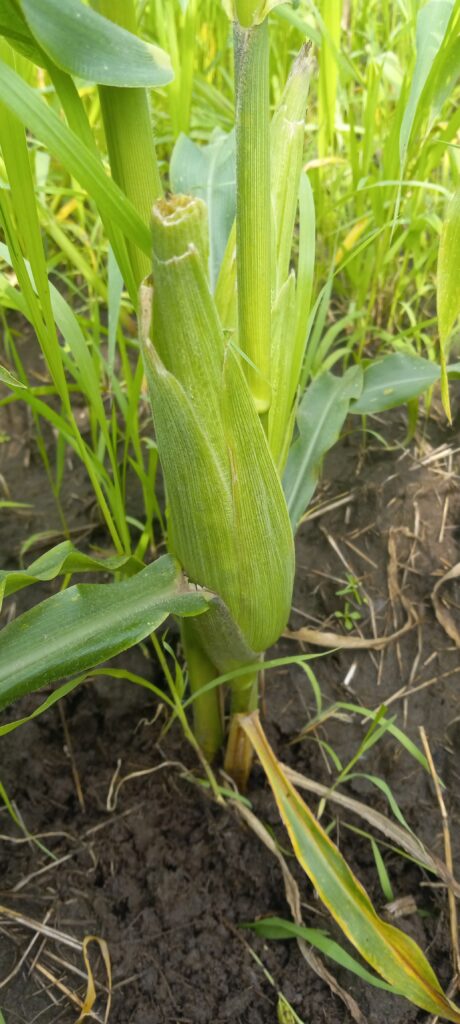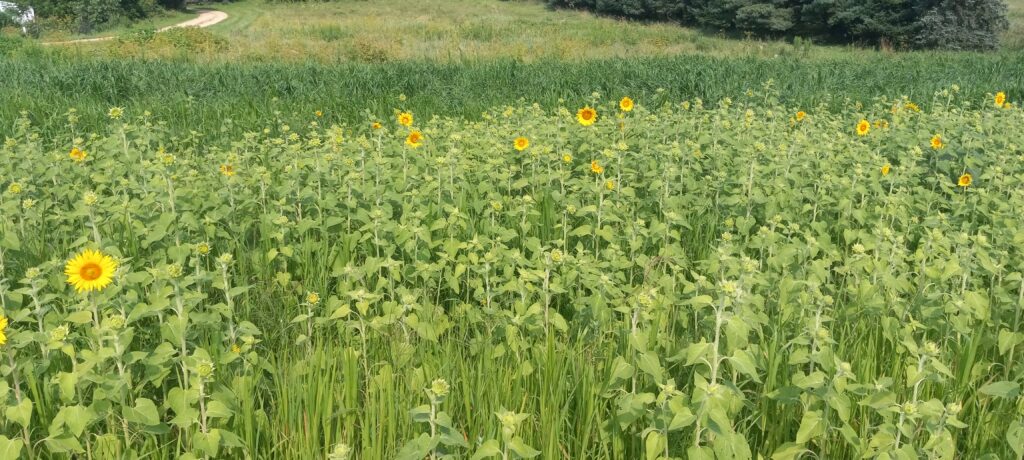
As of Monday it is still too wet to dig up any of our underground veggies. One of these days the rain will stop then we can dig carrots, potatoes and most importantly from a timing perspective the garlic. Looking at the forecast, Friday looks like a good garlic digging day. We’d love to have help! If you are available, and want to get dirty — not really dirty though, more like PG13 dirty — come join us! Many hands make light work. It is pretty easy; however with the amount of garlic we grow it is quite time consuming. Let’s start at 9:00 and go until we are done. Come anytime if you can’t make it by 9, though I have to quit around 3:30 to setup the pick-up tent..
A friend of the farm (and previous member who felt we made farming look so fun she decided to start her own hobby farm) has a whole bunch of homemade wild raspberry jam for sale. Tracy contacted me to see if our members would be interested. I have to believe many of you would be but I can’t be sure unless I ask. So, who’s interested in homemade, wild raspberry jam? The price would be $10 a pint ($11 if purchased online to cover the cost of credit card fees). Let me know if you are interested and if you want more than one let me know that too. We need to have enough interest to make it worthwhile for Tracy to make the trip.
What will we have this week?
The zucchini will continue until morale improves!
Yes we are still getting a lot of zucchini, even more cucumbers, (I’m starting to feel like we are a cucumber/zucchini farm). We also have basil, some cherry tomatoes, some tomatillos, eggplants, some okra, onions, some broccoli, some cabbage, some Napa cabbage, some pickling cucumbers, maybe some very small sweet corn (see below) and some green beans! There may be other things I am forgetting.
We have fruit this week! It includes cherries, blueberries, grapes, nectarines and strawberries. The cherries this week (at least for the Tuesday/Wednesday shares) seem quite ripe but quite tasty as well. I suggest eating these first.
We have cheese this week! It includes Shepard’s Hope Aleppo, a unique mild, fresh cheese with a gentle citrus note at the finish; Hidden Falls, a bloomy rind cheese with a light wildflower flavor; and Sogn, an award winning tomme with a wild, rustic rind and a white, crumbly interior that is salty and slightly fruity.
We have flowers this week! Flowers include but are not limited to zany zinnias, sunny sunflowers, happy gladiolas, far out cosmos, and a bunch of others too numerous to come up with special names for.
A Quick Note on Sweet Corn
I’m not sure what is going on with sweet corn this season but it is struggling in ways we haven’t seen before. In the first planting the plants are quite small and the ears are barely above ground level — makes for a lot of bending and stooping while picking. Typically the ears are at about knee level or higher if the plants are taller. With the smaller plants we have smaller ears, like really small. And not all the plants produced an ear at all. Finally, some of the ears have earworms. Typically earworms don’t arrive until later in the season but it isn’t completely unusual to see them in the early corn. Anyway, suffice it to say corn the is struggling (even later plantings are having issues). On the bright side we have a lot of cucumbers and zucchini!

Suggestion Box
Every day I check the suggestions box and every day there are no suggestions — except for the daily inclusion from one of (or perhaps all of) the employees suggesting we purchase air conditioned umbrella hats for all the farm workers.
Anyway, as you may recall from my last newsletter I was complaining about the seed companies disregard for the needs of their customers. One of our astute members suggested, “Hey Farmer Chris. Why don’t you just save your own seed? Then you don’t have to rely on those evil seed companies for your seeds.” I must say that is a great suggestion! Why don’t I save seeds? Well, sit back and let me fill you in on the long, torturous story of why we don’t save seeds.
Because many of the plants we grow are hybrids.
I guess it wasn’t that long of a story. But perhaps some of you are wondering why I can’t save seeds from hybrids? And what’s a hybrid? Is that one of those frankefood seeds genetically engineered from the DNA of salmon and a virus? Well, let me get into the truly long story.
Let’s start with “What are hybrid seeds/plants?” Hybrids are basically plants that could occur naturally but we humans take the initiative to act the role of bees and pollinate specific cultivar of a specific species of plant with another specifically selected cultivar of the same species of plant. In other words, we create a new seed/plant from preselected parent plants. Through years of carefully choosing parent plants and testing the resultant child plants, scientists find plants that perform to their desired goals and select those for productizing and selling to us unsuspecting farmers. It takes a lot of trials and errors to find a combination that performs better than the current plant. And each of these hybrids may perform well in some circumstances but not so well in others. As many of you know, the University of Minnesota has a breeding program that does this for apples and has successfully release many of the apples we eat today. It can take years to develop a new variety. It is not a business for those who demand immediate gratification.

That doesn’t explain why we can’t save seeds from a hybrid plant though. Well, technically we can save seeds from a hybrid plant. The problem is the resulting seed may not produce a plant that comes true to type. In other words, it won’t necessarily be like the parent plant. And each of the seeds we save may result in a different child plant that may or may not resemble the parent plant. We’d be taking a huge risk trying to grow plants from seeds saved from hybrids.
Hybrids are not the same as genetically modified organisms (GMOs) — though some people will claim they are and that we have been genetically modifying plants for centuries. But my definition, and the definition of anyone as smart or smarter than me, is GMOs are organisms that can’t form naturally. To create them we need to use science and technology to edit their genome and splice in genes that we think will add value to the organism. GMOs can fall into two categories — cisgenic and transgenic. Cisgenic organisms splice in only genes from the same species. I suppose a cisgenic organism could form naturally but it isn’t likely. Transgenic organisms have gene’s spliced in across species. These could never form naturally. Scientists have actually spliced salmon gene’s into tomatoes to try to create frost tolerant tomato plants. I don’t see how salmon and tomatoes could ever find each other in nature yet alone mate. Salmon flavored tomatoes do sound interesting though.
Anyway, back to hybridization, which again is not GMO. We could in theory create the same seeds we buy by growing the correct parent plants and crossing them ourselves, then saving the seeds from the resultant cross. But, that takes up time, space and resources we’d prefer to use someplace else. Plus we don’t know what the parentage is of the hybrid seeds we buy. I think they are corporate secrets.
So though it would make our farm more resilient if we could grow our own variety of seeds instead of buying seeds from a seed producer, it is not very efficient. Buying hybrid seeds is far cheaper than growing our own.
Feel free to stuff the suggestion box with other great suggestions!
Farm News
Maybe we don’t need too much farm news since we already covered all of this week’s suggestion from the suggestion box. But here are a couple of highlights.
It keeps raining. That’s both good and bad. Good if you are a weed. Bad if you are a farmer hoping to rid your farm of weeds, dig up underground produce, keep the diseases at bay and not be constantly wet from the rain or the dew. But it will end someday and we’ll be wanting it to rain again.
It has been hot! That’s both good and bad. Good if you are a warm season crop like sweet potatoes (though the deer are eating them), cucumbers, zucchini, squash, pumpkins, etc. Bad if you are a cool season crop like broccoli, cauliflower, peas, lettuce, etc. or a person working on a farm. Of the cool season crops we still have a few left to harvest. The main crop that is hurting from the heat is the broccoli. Broccoli forms funky heads when it grows in the hot weather. The rain can also cause a disease called brown bead. The heat and rain is also the perfect environment for black rot and alternaria to attack the broccoli (and other brassicas). So our broccoli is suffering quite a bit this season.

On the positive side, the tomatoes are just starting to ripen. Cherry tomatoes are on the incline and I suspect next week we should have a bunch of them. Big tomatoes are about a week or two behind the cherries. All the tomato plants are larger than normal (except the ones the deer pruned for us) and are loaded with fruit. I’m hoping we can start giving out loads of tomatoes to go with the loads of cucumbers soon.
By the way, I just want to let you know that so far we have been picking all the cukes from the first planting. Today we walked through the second planting and it looks like it will ramp up production by next week. I hope you really, really love cucumbers!
Recipe Ideas
Since we have so many cucumbers this season I asked the other farmers on our staff for some additional cucumber recipes. Here is one that I think you will enjoy. I have not tried it but I think the idea of combining refreshing cucumbers with chili oil and soy sauce sounds intriguing. Let me know if you try it and how you liked it!
Joke of the Week
Why did the Thai pepper put on a sweater?
It was a little chili.
If you want more of these great jokes please consider buying the wild berry jam since Tracy is the one who sent in this joke.
As always, send in your comments, suggestions, jam interest, questions, answers or anything else you think I should spend time reading.
